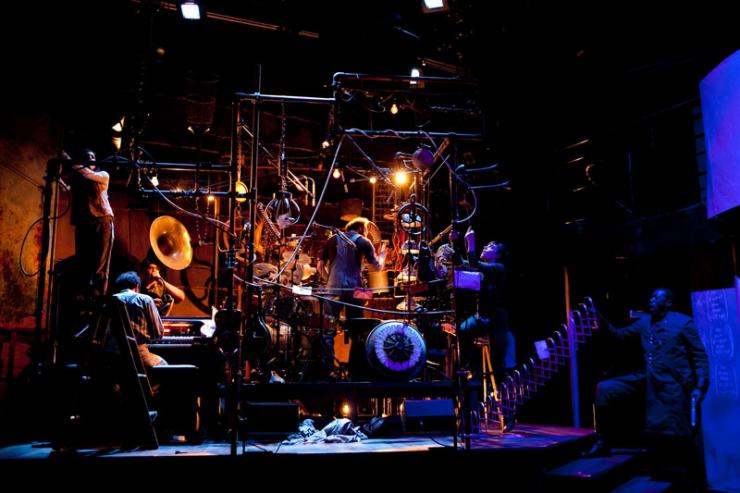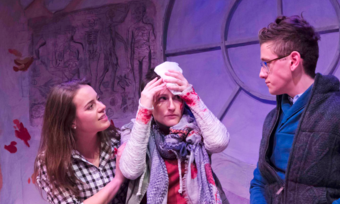“I’m Looking for a New Way To Be With You”
On The Lisps’ Futurity: A Musical
Elated, energized, and head spinning with songs about thought, technology, history, and dreams. I left a matinee performance of the Lisps’ performance of Futurity in Cambridge, MA with the conviction that I had just seen something important. A day later I read Don Aucoin’s review of the show in The Boston Globe. Aucoin clearly left this American Repetory Theater production in a different mood.
“UTOPIAN VISIONS RUN OUT OF STEAM.”1

On the way toward an explanation why Futurity is a remarkably timely production, I’d like to back up a bit to recognize the large and significant ideas Futurity expresses.
The future has always presented something a problem for the present. The shape of the contemporary changes according to the way it looks forward in at least partial blindness. History, of course, complicates the picture even as it proves necessary for thinking the relation between present and future. The bigger problem, I believe, is that the development of technology saturates contemporary life to such an extraordinary degree that the relation between present and future has become newly unhinged.
We relate to these things with “optimism,” a forward-looking-ness that may contain feelings of dread and pleasure as well as hope. The problem is—and here comes the cruelty part—our relation to these things very frequently gets in the way or damages the very hopes and dreams they make possible. Our relation to things opens up the possibility of a sense of futurity that the relationship actually forecloses.
The recent theatrical production of Futurity: A Musical at the American Repertory Theater in Cambridge, MA and at the Walker Art Center in Minneapolis powerfully engages and provides the occasion for thinking through these issues. Composed by César Alvarez and performed by his New York-based band The Lisps accompanied by an ensemble of actors and musicians, Futurity inquires into the relation of present and future through the dramatic exploration of a single bold idea: that a machine could create peace. Reviews of the play have thus far neglected to consider the significance of the choice to install such a bold idea at the center of the production In what follows, and in lieu of a longer investigation into a rich work full of ideas, I aim to affirm the contemporary vitality of Futurity by investigating the subtle cruelty of this single and challenging idea.
Futurity tells the story of Julian Munro, a Union solider in the Civil War who daydreams of a machine that might end not just the Civil War, but human strife altogether. Through correspondence with Ada Lovelace, daughter of Lord Byron and arguably the first computer programmer, Munro develops the idea of a “Steam Brain,” a 19th century version of artificial intelligence. As a line from the play states, the Steam Brain a “machine that creates peace.” This is far from an “innocent” or naïve conceit. More strongly, it is a frankly cruel idea.
Historians of technology frequently align its history with that of war. At least since the advent of the nuclear bomb, and the emergence of the possibility of ending all life on Earth via technological means, the prospect of entertaining any unequivocally optimistic belief in technology has been impossible. Or at least extremely naïve. And thus the Lisps’ Futurity takes place in the Nineteenth Century. It takes place at a moment in history, or perhaps several disjunct moments, in which it was actually possible to imagine technology differently than we do today, a time in which it was not only possible but actually the enlightened and educated norm to understand technology and science as unqualified forces for the rational betterment of mankind, or as the Victorians might say, for capital M Man.
This is a cruel proposition because we know what comes next. And the play lets us know that it also knows. Consider these lines from “Arkansas,” Futurity’s opening song:
Craziest thing that ever I saw,
Big balloon floating up o’er the Arkansas.
And up to the heavens it was bound to go,
Craziest thing that ever I’d know.
Most wonderful thing I could make believe
Was a world where peace was a reigning queen.
I dreamt in on the banks of the Arkansas,
Most wonderful thing that ever I saw.
This song plays the conventional role of establishing the play’s action in time and space. Yet time and space have become a bit unhinged. The lyrics are largely, and notably, retrospective. The lyrics also establish the play’s main idea of the steam brain as a machine that makes peace. They also establish this idea as a past dream, a dream of the future as told by the dead and evoked by the song’s final, heartbreaking lyrics, which shift midverse to the future tense: “I lived my life and that is all. I’ll die right here on the Arkansas.”
And what about that “big balloon”? Is it a rubber balloon floating “up o’er” the Arkansas? More than likely, it refers to the development of hot air balloons and their strategic use in the Civil War. More poetically, the balloon in question is both and neither. It’s a strange and wondrous harbinger of a paradoxically present future to come that cannot be grasped in its full implications, of a dreamed future that drifts out of contact with human experience. Hot air balloons gave armies a new perspective from which to plan battles. That perspective from the air—for the 19th century—is one only occupied by angels. The bird’s eye point of view afforded by new technology is bound up with the perspective death affords.
Importantly, Futurity doesn’t transport its audience back to the strictly historical 19th century; it is not a period piece. Futurity belongs to the sub-genre of science fiction known as steampunk. It combines a historical imagination of the Victorian period with the themes and concerns of the present age of networks and ubiquitous computation. Not only does the audience know about biological warfare and drone aircraft, so does Futurity. The pleasure of much steampunk derives from the knowing wink-wink connection of audience and text in the recognition of present day technologies and themes imagined within the limits and the aesthetics of the 19th century. But Futurity does something quite challenging and original with this generic convention. The bold creative anachronisms of steampunk allows for wild flights of fancy that stretch the bounds of imagination. But it does not allow for the Steam Brain to be built. If the Steam Brain were just—“just!”—a version of artificial intelligence, then maybe it could be built. But Futurity cannot end with the triumph of the Steam Brain as a machine that creates peace. There is simply no possibility of recognition between twenty-first century experience and a nineteenth century aesthetic on this crucial and central idea. If the play actually could end with such a victory then it could not happen without some unforeseen contingency that would cloud the appearance of its emergence. We know peace can’t win. It can’t win in the Civil War. And given the indeterminate length of the so-called “War on Terror,” it doesn’t even appear to be an option. That is, even if the Steam Brain could be built—if peace might win—I don’t think we could recognize it if even if it even happened.
Futurity is, in short, a work for today. It is not a period piece or even a mere piece of steampunk escapism like Guy Ritchie’s recent Sherlock Holmes films. Futurity is a vision of the future from the point of view of the long ago past. Throughout the production I could not resist pitying the characters for what they could not know of the years after 1864, of the era after railroads, telegraphs, and trains. But I believe what was actually coming into view was a response to my own sense that today our attachment to technology governs our own sense of futurity but also simultaneously hinders our ability to pursue the visions it opens up.3
The protagonist of Futurity is perhaps not Julian Munro or Ada Lovelace, but rather this idea of a machine that creates peace. And here’s what I mean by my repeated statement that this is cruel. Futurity confronts its audience from the start with the pre-ordained foreclosure of its utopian aspiration.
The play pointedly does not endorse a utopian vision of technology. It dramatically engineers an encounter with our own difficult and damaged relation to technology today. To borrow a phrase from literary theorist Lauren Berlant, our relation to technology today might be described as one of “cruel optimism.”4 For Berlant, cruel optimism characterizes contemporary American culture. It names a form of relation people have to various things: lovers, politicians, material things, education, events, whatever. We cannot do without these things. And we cannot do without them because they figure prominently in the way we plan our futures, cultivate our everyday hopes and desires, or our sense of “futurity.” We relate to these things with “optimism,” a forward-looking-ness that may contain feelings of dread and pleasure as well as hope. The problem is—and here comes the cruelty part—our relation to these things very frequently gets in the way or damages the very hopes and dreams they make possible. Our relation to things opens up the possibility of a sense of futurity that the relationship actually forecloses.
To cite one admittedly insufficient example, Facebook and social media may foster desires and feelings of connectedness. Such services may also thwart those aspirations by providing another excuse to avoid talking in person. To cite another, a college education or a graduate degree may hold the promise of a better future, yet as is well known, student loan debt crushes many dreams before they can start. To cite another, voting again for a presidential candidate virtually synonymous with optimism, or simply “hope,” seems to many a cruel proposition in the wake of many recent political disappointments.
To return to Futurity, technology allows us to dream big, but it also destroys dreams. But technology is not just another object like social media or student loan debt. The relation between technology and futurity runs much deeper. It is perhaps not hyperbole to say that it is very nearly impossible to imagine the future without talking about technology. Here I have in mind ideas of the future invoked by questions like “what will the world be like in 50 years?” What form will artificial intelligence take? How will nanotechnology blossom? Will there be a cure for cancer? These are questions relating to technology. Of course, the answers to such questions remain open. The only agreeable “certainty” is that the future will be characterized by further and accelerated technological innovation. Significantly, such implicit quasi-certainty renders the future unimaginable. At the present moment, then, futurity belongs more to machines and the story of their development than to us. As the plotlines of many dystopian science fiction movies attest, there is a deep thread in our relation to technology today that precludes the very sense of a future to which we not only would like to belong but to which we belong at all.
Futurity produces for its audience an encounter with a historical sense of cruel optimism. The “touchingly innocent” “belief in technology as a force for peace” belongs to the character of Julian Munro of the 34th Ohio Infantry. And maybe it belongs to the character of Ada Lovelace. But it does not belong to Futurity as a whole. And it does not belong to us as audience members—at least not in anything like the same way that it does for Julian. The divide between Julian and the audience is decisive. In a way, we know too much to really invest in Julian’s desperate dreams. The “Steam Brain” can’t work; we don’t recognize it as possible. But we do recognize the logic of Julian’s desire. And in his dreams we still may find and cultivate a critical and aesthetic recognition of our own contemporary relation to technology.
The dynamic push and pull between the dream of the Steam Brain and dark cloud of historical reality emerges in the gap between the production’s use of Brechtian alienation effects of the dramatic sequences and the infectious energy of the musical numbers. The portrayal of the life of soldiers is neither whimsical nor somber. Instead the characters inhabit something of an unreal cardboard cut-out existence. The actors grant the soldiers no deep psychological reality, the rifles do not resemble real firearms, and the “Sargeant” addresses the soldiers from a spotlit area across the theater space as if appearing in a vision rather than in any semblance of an encampment. The musical numbers have tremendous energy. They partake of the structural utopianism of the musical, its numbers as so many possible suspensions of reality and flights from the harsh conditions of war and inevitable death.5 Musicals generically hold out the punctuated possibility of utopia as one more song, one more number, one more encore. The songs in Futurity engineer new affects of possibility. The kinds of possibility they open, however, offer anything but straightforward escapism or liberation. The musical numbers in Futurity are not flights of fancy away from reality so much as uneasy flights from unreality. We are swept up but not away. If anything we are swept into the hurtful maelstrom of imagination that animates a desire to escape history through new forms of shared imagination for the future.
In one of the more stand-out lyrics, Munro intones, “Ada, I’m looking for a new way to be with you.” Julian sings these words near the end of the play, on the eve of battle and seemingly inevitable death while writing a final letter to Lovelace. It is very nearly a love song. But it is really something else. “Ada,” Julian sings, “I’m looking for something to look forward to.” And she joins him to proclaim, “I’m no utopian/ But I can get up again/ Over and over again.” This song is not about shared love so much as a shared relation of endurance. Julian and Ada endure in the face of the inevitable and the desire to find a new way not simply to be but to be with each other and the cruel optimism of their shared creativity and enthusiasm for an impossible future.
Lovelace, of course, was a real historical person. And even as her achievements were obscure for too long, she has become recognized as the “first programmer.” The story is different for Julian. He is a fiction. And the theatrical reality of his statement, “I’m looking for a new way to be with you” underscores the sense in which he has only ever barely been present as the placeholder for the audience’s critical recognition of an impossible idea, a ghostly and virtual presence situated uncertainly in the incipient alliance of the Industrial Revolution, the military-industrial complex, and the information age. When Munro addresses Ada plaintively and says “I’m looking for a new way to be with you,” he voices a larger desire to exist in a different time and space. To be with Lovelace—who was real, but who died before the Civil War. And more tellingly, his desire is not simply to be with her but for a way to be at all.
“Thinking,” one of the most remarkable songs in Futurity, expresses these ideas and more. Lovelace sings the song, seeming to give a precise explanation of how mechanical technology might give rise to artificial intelligence—the Steam Brain. The chorus expresses both the hopeful audacity of pure imagination as well as a sense of resignation in the face of historical inevitability: “But a machine is not a thinking being. It simply acts according to the laws imposed upon it. Thinking…I know, I know.” The repetition of “I know” references Descartes’ famous cogito (I think therefore I am). And it also voices more than an affirmation of rational humanity. As the song ends, “I know, I know” sounds increasingly like someone acknowledging the bitter pill of an unvoiced impossibility. “I know, I know.” Futurity’s final song, “Singularity” returns to this idea in its final lines: “Oh, I don’t know. Oh, I don’t know.” Facing the future together entails embracing a cruelty of not knowing amplified by the accelerated development of technology at the beginning of the twenty-first century. The reality that we simply cannot know the future, and that machines may not help, is a truth that hurts. But is also a truth to share as a basis for our fears as well as our hopes.
*
Thanks to Ivan Ross, Judy Hodge, and César Alvarez for their help and comments.
1 Don Aucoin, “Utopian Visions Run Out of Steam in ‘Futurity.’" The Boston Globe, March 23, 2012, G3–4.
2 Fuller credits for Futurity run as follows: music by César Alvarez and The Lisps; lyrics by César Alvarez; book by Molly Rice and César Alvarez; directed by Sarah Benson; and production design by Emily Orling.
3 The steam brain is never quite shown on stage. Might its described destruction at play’s end actually contain the possibility of its triumph?
4 Lauren Berlant, Cruel Optimism (Durham: Duke University Press, 2011).
5 See Rick Altman, “The Musical,” in The Oxford History of World Cinema, ed. Geoffrey Nowell-Smith (New York: Oxford University Press, 1996).









Comments
The article is just the start of the conversation—we want to know what you think about this subject, too! HowlRound is a space for knowledge-sharing, and we welcome spirited, thoughtful, and on-topic dialogue. Find our full comments policy here